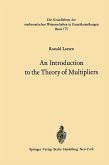Vector lattices-also called Riesz spaces, K-lineals, or linear lattices-were first considered by F. Riesz, L. Kantorovic, and H. Freudenthal in the middle nineteen thirties; thus their early theory dates back almost as far as the beginning of the systematic investigation of Banach spaces. Schools of research on vector lattices were subsequently founded in the Soviet Union (Kantorovic, Judin, Pinsker, Vulikh) and in Japan (Nakano, Ogasawara, Yosida); other important contri butions came from the United States (G. Birkhoff, Kakutani, M. H. Stone). L. Kantorovic and his school first recognized the importance of studying vector lattices in connection with Banach's theory of normed vector spaces; they investigated normed vector lattices as well as order-related linear operators between such vector lattices. (Cf. Kantorovic-Vulikh-Pinsker [1950] and Vulikh [1967].) However, in the years following that early period, functional analysis and vector lattice theory began drifting more and more apart; it is my impression that "linear order theory" could not quite keep pace with the rapid development of general functional analysis and thus developed into a theory largely existing for its own sake, even though it had interesting and beautiful applications here and there.
Hinweis: Dieser Artikel kann nur an eine deutsche Lieferadresse ausgeliefert werden.
Hinweis: Dieser Artikel kann nur an eine deutsche Lieferadresse ausgeliefert werden.








